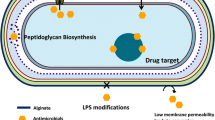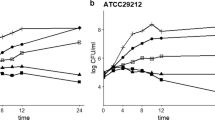Abstract
Biofilm plays an important role in the community and hospital-acquired infections. Especially E. coli biofilm that contributes towards the significant part of medical devices associated with microbial infections. OmpR/EnvZ, a two-component system, is one of the regulatory mechanisms involved in transcription regulation in response to environmental osmolarity changes. The main objective of this study was to elucidate the role of the OmpR/EnvZ two-component system in regulating the biofilm through curli and fimbriae (FimH gene), a contrary approach towards biofilm inhibition. In this study, the CRISPRi technique was used to suppress the expression of the OmpR gene. The RT-PCR assay was performed to quantify mRNA gene expression of curli and biofilm producing genes, and the data were further confirmed by different microscopic, spectroscopic and biofilm quantification assay (Crystal Violet). It is the first time we have shown downregulation of the OmpR gene in biofilm causing clinical isolates of E. coli, which further suppressed the FimH gene, leading to biofilm reduction. The crystal violet assay and microscopic studies also confirmed the biofilm reduction. We conclude that the OmpR gene of the OmpR/EnvZ two-component system could be one of the targets for biofilm mediated infection intervention. Our findings open new vistas to explore the pathways and targets to control biofilm mediated infections.





Similar content being viewed by others
References
Shimada T, Takada H, Yamamoto K, Ishihama A (2015) Expanded roles of two-component response regulator OmpR in Escherichia coli: genomic SELEX search for novel regulation targets. Genes Cells 20(11):915–931. https://doi.org/10.1111/gtc.12282
Zhang W et al (2020) Escherichia coli adhesion portion FimH functions as an adjuvant for cancer immunotherapy. Nat Commun. https://doi.org/10.1038/s41467-020-15030-4
Bien J, Sokolova O, Bozko P (2012) Role of uropathogenic Escherichia coli virulence factors in development of urinary tract infection and kidney damage. Int J Nephrol 2012:681473. https://doi.org/10.1155/2012/681473
Pratt LA, Kolter R (1998) Genetic analysis of Escherichia coli biofilm formation: roles of flagella, motility, chemotaxis and type I pili. Mol Microbiol 30(2):285–293. https://doi.org/10.1046/j.1365-2958.1998.01061.x
Melican K et al (2011) Uropathogenic Escherichia coli P and type 1 fimbriae act in synergy in a living host to facilitate renal colonization leading to nephron obstruction. PLoS Pathog 7(2):2–13. https://doi.org/10.1371/journal.ppat.1001298
Johnson JR (1991) Virulence factors in Escherichia coli urinary tract infection. Clin Microbiol Rev 4(1):80–128. https://doi.org/10.1128/CMR.4.1.80
Tchesnokova V et al (2011) Type 1 fimbrial adhesin FimH elicits an immune response that enhances cell adhesion of Escherichia coli. Infect Immun 79(10):3895–3904. https://doi.org/10.1128/IAI.05169-11
Chahales P, Thanassi DG (2015) Assembly of adhesive organelles by uropathogenic bacteria. Microbiol Spectr 3:1–39
Derakhshandeh S et al (2020) Surface display of uropathogenic Escherichia coli FimH in Lactococcus lactis: in vitro characterization of recombinant bacteria and its protectivity in animal model. Microb Pathog 141(September 2019):103974. https://doi.org/10.1016/j.micpath.2020.103974
Ishihama A (2010) Prokaryotic genome regulation: multifactor promoters, multitarget regulators and hierarchic networks. FEMS Microbiol Rev 34(5):628–645. https://doi.org/10.1111/j.1574-6976.2010.00227.x
Ishihama A (2012) Prokaryotic genome regulation: a revolutionary paradigm. Proc Jpn Acad Ser B 88(9):485–508. https://doi.org/10.2183/pjab.88.485
Pukklay P, Nakanishi Y, Nitta M, Yamamoto K, Ishihama A, Shiratsuchi A (2013) Involvement of EnvZ-OmpR two-component system in virulence control of Escherichia coli in Drosophila melanogaster. Biochem Biophys Res Commun 438(2):306–311. https://doi.org/10.1016/j.bbrc.2013.07.062
Pratt LA, Hsing W, Gibson KE, Silhavy TJ (1996) From acids to osmZ: multiple factors influence synthesis of the OmpF and OmpC porins in Escherichia coli. Mol Microbiol 20(5):911–917. https://doi.org/10.1111/j.1365-2958.1996.tb02532.x
Forst S, Inouye M (1988) Environmentally regulated gene expression for membrane proteins in Escherichia coli. Annu Rev Cell Biol 4:21–42. https://doi.org/10.1146/annurev.cb.04.110188.000321
Hirakawa H, Nishino K, Hirata T, Yamaguchi A (2003) Comprehensive studies of drug resistance mediated by overexpression of response regulators of two-component signal transduction systems in Escherichia coli. J Bacteriol 185(6):1851–1856. https://doi.org/10.1128/JB.185.6.1851
Liu X, Ferenci T (2001) An analysis of multifactorial influences on the transcriptional control of ompF and ompC porin expression under nutrient limitation. Microbiology 147(11):2981–2989. https://doi.org/10.1099/00221287-147-11-2981
Wang LC, Morgan LK, Godakumbura P, Kenney LJ, Anand GS (2012) The inner membrane histidine kinase EnvZ senses osmolality via helix-coil transitions in the cytoplasm. EMBO J 31(11):2648–2659. https://doi.org/10.1038/emboj.2012.99
Kenney LJ, Bauer MD, Silhavy TJ (1995) Phosphorylation-dependent conformational changes in OmpR, an osmoregulatory DNA-binding protein of Escherichia coli. Proc Natl Acad Sci U S A 92(19):8866–8870. https://doi.org/10.1073/pnas.92.19.8866
Forst S, Delgado J, Inouye M (1989) Phosphorylation of OmpR by the osmosensor EnvZ modulates expression of the ompF and ompC genes in Escherichia coli. Proc Natl Acad Sci U S A 86(16):6052–6056. https://doi.org/10.1073/pnas.86.16.6052
Garrett S, Igo MM, Silhavy TJ (1988) EnvZ, a transmembrane environmental sensor of Escherichia coli K-12, is phosphorylated in vitro. J Bacteriol 170(12):5971–5973. https://doi.org/10.1128/jb.170.12.5971-5973.1988
Mattison K, Kenney LJ (2002) Phosphorylation alters the interaction of the response regulator OmpR with its sensor kinase EnvZ. J Biol Chem 277(13):11143–11148. https://doi.org/10.1074/jbc.M111128200
Ames SK, Frankema N, Kenney LJ (1999) C-terminal DNA binding stimulates N-terminal phosphorylation of the outer membrane protein regulator OmpR from Escherichia coli. Proc Natl Acad Sci U S A 96(21):11792–11797. https://doi.org/10.1073/pnas.96.21.11792
Pratt LA, Silhavy TJ (1995) Identification of base pairs important for OmpR-DNA interaction. Mol Microbiol 17(3):565–573. https://doi.org/10.1111/j.1365-2958.1995.mmi_17030565.x
Mjzuno T, Mizushima S, Mizuno T, Mizushima S (1990) Signal transduction and gene regulation through the phosphorylation of two regulatory components: the molecular basis for the osmotic regulation of the porin genes. Mol Microbiol 4(7):1077–1082. https://doi.org/10.1111/j.1365-2958.1990.tb00681.x
Rentschler AE, Lovrich SD, Fitton R, Enos-Berlage J, Schwan WR (2013) OmpR regulation of the uropathogenic Escherichia coli fimB gene in an acidic/high osmolality environment. Microbiology 159(2):316–327. https://doi.org/10.1099/mic.0.059386-0
Oshima T et al (2002) Transcriptome analysis of all two-component regulatory system mutants of Escherichia coli K-12. Mol Microbiol 46(1):281–291. https://doi.org/10.1046/j.1365-2958.2002.03170.x
Schwan WR, Lee JL, Lenard FA, Matthews BT, Beck MT (2002) Osmolarity and pH growth conditions regulate fim gene transcription and type 1 pilus expression in uropathogenic Escherichia coli. Infect Immun 70(3):1391–1402. https://doi.org/10.1128/IAI.70.3.1391-1402.2002
Azam MW, Zuberi A, Khan AU, Khan AU (2020) BolA gene involved in curli amyloids and fimbriae production in E. coli: exploring pathways to inhibit biofilm and amyloid formation. J Biol Res 27(1):1–12. https://doi.org/10.1186/s40709-020-00120-7
Zuberi A, Ahmad N, Khan AU (2017) CRISPRi induced suppression of fimbriae gene (fimH) of an uropathogenic Escherichia coli: an approach to inhibit microbial biofilms. Front Immunol. https://doi.org/10.3389/fimmu.2017.01552
Parvez S, Khan AU (2018) Hospital sewage water: a reservoir for variants of New Delhi metallo-β-lactamase (NDM)- and extended-spectrum β-lactamase (ESBL)-producing enterobacteriaceae. Int J Antimicrob Agents 51(1):82–88. https://doi.org/10.1016/j.ijantimicag.2017.08.032
Ahmad N, Khalid S, Ali SM, Khan AU (2018) Occurrence of blaNDM variants among enterobacteriaceae from a neonatal intensive care unit in a Northern India Hospital. Front Microbiol 9:407
Zuberi A, Misba L, Khan AU (2017) CRISPR interference (CRISPRi) inhibition of luxS gene expression in E. coli: an approach to inhibit biofilm. Front Cell Infect Microbiol 7(MAY):1–7. https://doi.org/10.3389/fcimb.2017.00214
Jubelin G et al (2005) CpxR/OmpR interplay regulates curli gene expression in response to osmolarity in Escherichia coli. J Bacteriol 187(6):2038–2049. https://doi.org/10.1128/JB.187.6.2038-2049.2005
Gallo PM et al (2015) Amyloid-DNA composites of bacterial biofilms stimulate autoimmunity article amyloid-DNA composites of bacterial biofilms stimulate autoimmunity. Immunity 42:1171–1184. https://doi.org/10.1016/j.immuni.2015.06.002
Samanta P, Clark ER, Knutson K, Horne SM, Prüß BM (2013) OmpR and RcsB abolish temporal and spatial changes in expression of flhD in Escherichia coli biofilm. BMC Microbiol. https://doi.org/10.1186/1471-2180-13-182
Perni S, Preedy EC, Landini P, Prokopovich P (2016) Influence of csgD and ompR on nanomechanics, adhesion forces, and curli properties of E. coli. Langmuir 32(31):7965–7974. https://doi.org/10.1021/acs.langmuir.6b02342
Fowler DM, Koulov AV, Balch WE, Kelly JW (2007) Functional amyloid - from bacteria to humans. Trends Biochem Sci 32(5):217–224. https://doi.org/10.1016/j.tibs.2007.03.003
Giraud A et al (2008) Dissecting the genetic components of adaptation of Escherichia coli to the mouse gut. PLoS Genet 4(1):0052–0061. https://doi.org/10.1371/journal.pgen.0040002
Tobe T (2008) The roles of two-component systems in virulence of pathogenic Escherichia coli and Shigella spp. Adv Exp Med Biol 631:189–199. https://doi.org/10.1007/978-0-387-78885-2_13
Montanaro L et al (2011) Extracellular DNA in biofilms. Int J Artif Organs 34(9):824–831. https://doi.org/10.5301/ijao.5000051
Acknowledgements
DST-PURSE Phase-II created facilities are highly acknowledged.
Funding
This work was supported by internal funds of the Interdisciplinary Biotechnology Unit, AMU, Aligarh, India.
Author information
Authors and Affiliations
Contributions
AZ designed problem, performed experiments, analyzed data and wrote the manuscript, MWA performed experiments and wrote part of the manuscript, AUK designed problem, analyzed data and edited the draft manuscript.
Corresponding author
Ethics declarations
Conflict of interest
The authors declare no conflict of interest.
Ethical Approval
All the strains used in this study are already published strains which has already been approved from institutional ethical committee before these were published.
Additional information
Publisher's Note
Springer Nature remains neutral with regard to jurisdictional claims in published maps and institutional affiliations.
Supplementary Information
Below is the link to the electronic supplementary material.
Rights and permissions
About this article
Cite this article
Zuberi, A., Azam, M.W. & Khan, A.U. CRISPR Interference (CRISPRi) Mediated Suppression of OmpR Gene in E. coli: An Alternative Approach to Inhibit Biofilm. Curr Microbiol 79, 78 (2022). https://doi.org/10.1007/s00284-021-02760-x
Received:
Accepted:
Published:
DOI: https://doi.org/10.1007/s00284-021-02760-x




